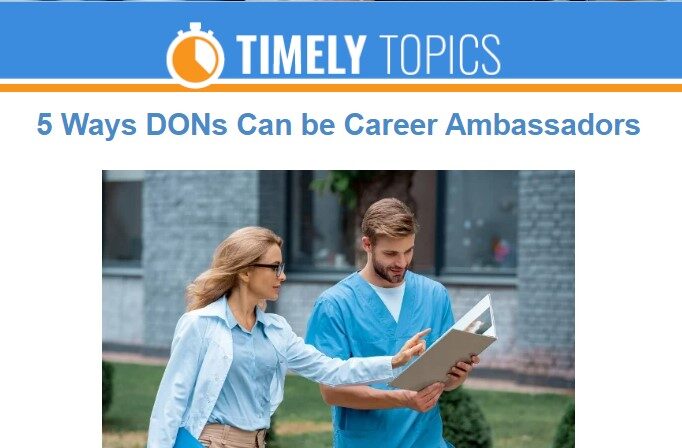

Skilled Nursing
Articles

5 Ways DONs Can Be Career Ambassadors
August 21, 2023DONs are some of the best advocates and recruiters for careers in long-term care. “I have talked to student nurses and told them to give nursing homes a chance. I tell them how this is a great setting to hone their skills and that they don’t need to go to acute care for that,” said Nancy Propes, RN-BC, CDONA, FACDONA, a founding member of NADONA. She added, “I help them understand that, in long-term care, we are working to get residents back to the community, and we are really getting people to the next level by addressing things like wound care, trach care, cardiac rehab, dialysis, and diabetes care.” Propes offered 5 tips for DONs to help attract and engage nurses, whether they are students or mid-career professionals:
- Work to get student nurses into your facilities as part of their training. This presents an opportunity for them to learn, use, and fine- tune their clinical skills. “We can introduce them to nursing home care, engage them with the residents, involve them in care planning, etc. And hopefully they’ll fall in love with the environment,” said Propes. If not, they still gain skills they can use in other settings.
- Welcome nurses from acute care. “We see nurse managers from acute care who are burned out. They can bring great skill sets and leadership abilities. We need to invite them to consider long-term care, but we need to educate them about the unique aspects of this setting, particularly the regulations,” said Propes.
- Prepare nurses for leadership roles. “You want to take advantage of opportunities to help them learn,” Propes advised, adding, “When I was a DON, I looked for people to groom to take my job. Specifically, I would look for individuals with natural leadership ability and/or the desire to learn, grow, and advance.” Facilities may want to consider establishing a leadership training program that nurtures nurses and others who have the potential and desire to move forward on their career path. This might involve efforts such as putting them on QAPI committees, offering unit management opportunities, and encouraging their participation in state and national professional associations. At the same time, she stressed, let potential leaders know what they’re getting into – such as the hours they’ll be expected to work, responsibilities for clinical care, communication with the board and administration, and staff hiring and training. “If they aren’t prepared, they won’t last,” Propes said.
- Really know your team. Propes said, “You have to connect with your people and understand who they are, what they want, and why they are here.” Once you know what is important to each employee and who they are as a person, you can personalize training, rewards, and motivations. “We way overdid the pizza party,” she said, adding, “Some of our CNAs barely make ends meet. We need to develop programs that enable them to get food and other things they need to care for their families. This is one area where you can use creativity as a nurse.”
- Engage people early on. “We need to get them young – as early as middle and high school,” advises Propes. This means planting the seed by going to career days and assemblies and talking about the different positions in long-term care and what kind of training they’ll need. She also suggests engaging young people in the community. For instance, a local high school football team comes into her facility and does Bingo with the residents. “I spent time in nursing homes when I was young, and I was immersed in an environment that put a lot of value on older adults. It made an impression on me,” Propes shared.
Getting the word out and sharing stories is essential. As Propes said, “People think you work in nursing homes because you can’t cut it in acute care. Actually, it’s the opposite. You need to know how to multi-task, prioritize, and be part of a true interdisciplinary team. Everyone works together to care for the most vulnerable population.”
